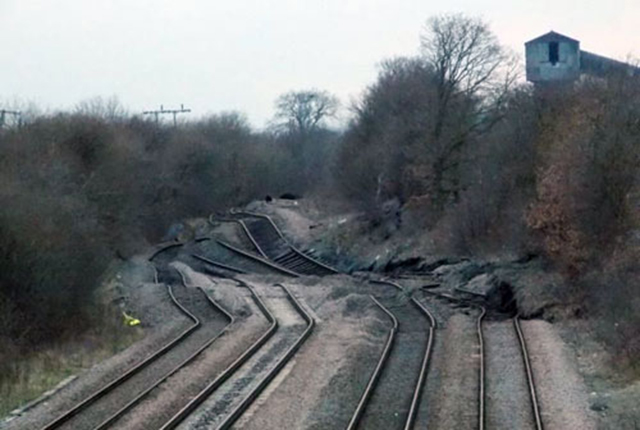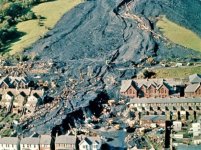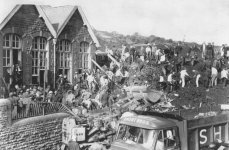An event so terrible and so, comparatively, recent. It saw the loss of 144 people, 116 of which were children - I feel the day shouldn't pass without mention - Aberfan 21/10/1966 R.I.P.
You are using an out of date browser. It may not display this or other websites correctly.
You should upgrade or use an alternative browser.
You should upgrade or use an alternative browser.
Aberfan
- Thread starter ncbnik
- Start date
Steve Clark
Well-known member
Aberfan happened a good few years before I was born, but I have strong memories of the giant B&W framed aerial photograph that dominated the wall of our Geotechnics Lab in the Engineering Dept at Cambridge Uni. Somewhere I spent many hours on my final year project. The photo always loomed over everything in the lab.
Very worryingly, an even larger waste slip (in volume) happened at Hatfield Colliery in 2013(!), over a decade after I graduated. Whilst I'm not aware of anyone being injured, the fact that this kind of thing can be allowed to develop adjacent to a main line railway is just fundamentally wrong.
When events like Aberfan fade from memory, the importance of the lessons learnt fade as well.
Very worryingly, an even larger waste slip (in volume) happened at Hatfield Colliery in 2013(!), over a decade after I graduated. Whilst I'm not aware of anyone being injured, the fact that this kind of thing can be allowed to develop adjacent to a main line railway is just fundamentally wrong.
When events like Aberfan fade from memory, the importance of the lessons learnt fade as well.
The Hatfield slip didn't bury anything (report pages 42-48):


 www.bgs.ac.uk
www.bgs.ac.uk
A "smaller" slip of 60,000 tonnes occurred at tylorstown in 2000 and work has only just finished, with an update to laws created after aberfan being considered by Welsh government:
Whilst aberfan had a previous slip in 1944, but because nobody was injured it was ignored:

 www.geolsoc.org.uk
www.geolsoc.org.uk

 www.geolsoc.org.uk
www.geolsoc.org.uk


Hatfield Colliery, South Yorkshire - British Geological Survey
On 12 February 2013 the BGS Landslide Response Team received reports of a landslide affecting the railway near Hatfield and Stainforth Station.
A "smaller" slip of 60,000 tonnes occurred at tylorstown in 2000 and work has only just finished, with an update to laws created after aberfan being considered by Welsh government:
Tylorstown landslip – remediation process | Rhondda Cynon Taf County Borough Council
This webpage contains information about the significant ongoing remediation process following the Tylorstown landslip, due to unprecedented weather during Storm Denn
www.rctcbc.gov.uk
Whilst aberfan had a previous slip in 1944, but because nobody was injured it was ignored:

The Geological Society of London - Tipping point
Ted Nield describes Britain’s worst mining-related disaster 50 years ago this month, from which grew a new awareness of engineering geology’s importance.

The Geological Society of London - Aberfan's engineering legacy
Paul Maliphant, Helen Reeves, Bob Leeming and Darren Bryant revisit the Aberfan Disaster and ask – what did we learn? A new plaque in remembrance of the former Merthyr Vale Colliery, unveiled in 2015 as part of the redevelopment of the colliery surface for housing, reads: Merthyr Vale...
Tim Pickering
Active member
A horrendous disaster and sickening in the way it was handled. I wrote a short essay on this for a geohazards module during uni.
davel
Active member
I remember it happening, but not until many years later did I hear how the disaster fund was administered.A horrendous disaster and sickening in the way it was handled.
... The most controversial aspect of the recovery was that after the National Coal Board and Treasury refused to accept full financial responsibility, the Fund ended up having to contribute £150,000 for the removal of the remaining tips overlooking the village. Despite the outrage of donors, villagers and the local MP, it was not until 1997 that this money was repaid to the Fund. The fact that the original disaster fund was seen as being plundered by Government for safety work on the tips remained with local people for over 40 years. It was felt that the fund should have been used solely for the victims and the memorial.
paul
Moderator
Quoted from the link below:
It had slipped three years previously when an ominous crater appeared at the top.
A bulge had formed at the foot of the tip as mountain spring water, unable to drain away, liquefied the spoil into thick, black quicksand.
The NCB brushed complaints aside.
The threat was implicit - make a fuss and the mine would close.
While many spoke out about the dangers, others who had misgivings held their tongue, recalling grim memories of long years of unemployment in the valleys.
At 07:30 that Friday the tip was reported to have sunk 20ft.

The tips above the village
If only fate had played its hand 20 minutes earlier, the school would have been empty.
One tipping gang worker told a subsequent inquiry how the slide began.
“It was starting to come back up,” he said. “It started to rise slowly at first, sir… I thought I was seeing things. Then it rose up pretty fast, sir, at a tremendous speed.
"Then it sort of came up out of the depression and turned itself into a wave… down towards the mountain… towards Aberfan village… into the mist.”
Seconds later the bottom of the tip shot out.
Down in Pantglas Junior School the lights began to flicker and sway; an ominous roar like “a jet plane screaming low over the school in the fog”.
The glistening black avalanche consumed rocks, trees, farm cottages then ruptured the Brecon Beacons to Cardiff water main, engorging it further and increasing the velocity of its murderous descent towards Pantglas.
Seconds after it hit, Cyril Vaughan, a teacher at the neighbouring senior school, said “everything was so quiet”.
“As if nature had realised that a tremendous mistake had been made and nature was speechless.”
It had slipped three years previously when an ominous crater appeared at the top.
A bulge had formed at the foot of the tip as mountain spring water, unable to drain away, liquefied the spoil into thick, black quicksand.
The NCB brushed complaints aside.
The threat was implicit - make a fuss and the mine would close.
While many spoke out about the dangers, others who had misgivings held their tongue, recalling grim memories of long years of unemployment in the valleys.
At 07:30 that Friday the tip was reported to have sunk 20ft.

The tips above the village
If only fate had played its hand 20 minutes earlier, the school would have been empty.
One tipping gang worker told a subsequent inquiry how the slide began.
“It was starting to come back up,” he said. “It started to rise slowly at first, sir… I thought I was seeing things. Then it rose up pretty fast, sir, at a tremendous speed.
"Then it sort of came up out of the depression and turned itself into a wave… down towards the mountain… towards Aberfan village… into the mist.”
Seconds later the bottom of the tip shot out.
Down in Pantglas Junior School the lights began to flicker and sway; an ominous roar like “a jet plane screaming low over the school in the fog”.
The glistening black avalanche consumed rocks, trees, farm cottages then ruptured the Brecon Beacons to Cardiff water main, engorging it further and increasing the velocity of its murderous descent towards Pantglas.
Seconds after it hit, Cyril Vaughan, a teacher at the neighbouring senior school, said “everything was so quiet”.
“As if nature had realised that a tremendous mistake had been made and nature was speechless.”
Tim Pickering
Active member
shotlighter
Active member
I was 9 when this happened and still remember watching the news of this with my nan. I remember feeling as if it was my school friends it had happened to. I still think of them this way nearly 60 years later and still feel so terribly sad when I think of it.
Lord knows how the surviving villagers feel.
Lord knows how the surviving villagers feel.
PeteHall
Moderator
I think all of us probably live with one legacy of Aberfan, whether or not we know it.
Following his controversial role in the aftermath of the disaster, Lord Robens was instrumental in bringing forward the Health and Safety at Work Act. Despite all the complaints we hear these days of Health and Safety gone mad, it is fair to say that it is much safer going to work now, than it was then.
I have been led to believe that Robens hands' were tied in relation to Aberfan and afterwards he was determined to make amends through the creation of the Health and Safety at Work Act, which has arguably saved many more lives than those lost on that tragic day in 1966.
Following his controversial role in the aftermath of the disaster, Lord Robens was instrumental in bringing forward the Health and Safety at Work Act. Despite all the complaints we hear these days of Health and Safety gone mad, it is fair to say that it is much safer going to work now, than it was then.
I have been led to believe that Robens hands' were tied in relation to Aberfan and afterwards he was determined to make amends through the creation of the Health and Safety at Work Act, which has arguably saved many more lives than those lost on that tragic day in 1966.
shotlighter
Active member
I think that's why it made such a powerfull impression on my young mind . I lived in a similar small active mining village and the school looked much like ours did did too.I was eight and lived in a Northumbrian ex-mining village surrounded by spoil heaps (much less threatening but prone to bursting into flames). It made an enormous impression...






